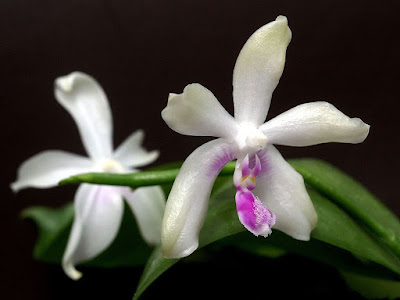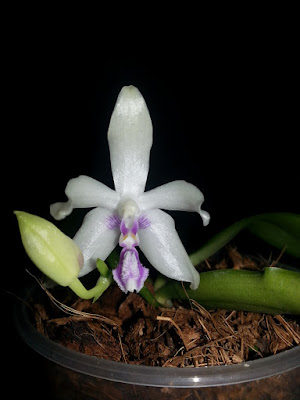The Fimbriate Phalenopsis is native to East and central Java, Sarawak and Sumatra. They grow on Mt. Kinabalu and mountain passes at heights of 792-1311 m. They usually grow on quite clear positions, on trees in the translucent sun or in moss on limestone cliffs. These cliffs face south or east, and the plants are exposed to bright, reflected light. Although Phalaenopsis fimbriata is often found growing from Phalaenopsis viridis, it usually does not survive transfer to warmer sites at lower altitudes.
Phalaenopsis fimbriata orchid, also called as The Fimbriate Phalenopsis (refers to the fimbriate trichomes on the mid-lobe of the lip), Phalaenopsis fimbriata f. alba, Phalaenopsis fimbriata subsp. sumatrana, Phalaenopsis fimbriata var. sumatrana, Phalaenopsis fimbriata var. tortilis, Polychilos fimbriata, is a species of the genus Phalaenopsis. This species was discovered by J.J. Smith in 1921 in Java, Indonesia.
IDENTIFY PHALAENOPSIS FIRMBRIATA ORCHID
The Fimbriate Phalenopsis is native to East and central Java, Sarawak and Sumatra. They grow on Mt. Kinabalu and mountain passes at heights of 792-1311 m. They usually grow on quite clear positions, on trees in the translucent sun or in moss on limestone cliffs. These cliffs face south or east, and the plants are exposed to bright, reflected light. Although Phalaenopsis fimbriata is often found growing from Phalaenopsis viridis, it usually does not survive transfer to warmer sites at lower altitudes.
It is a medium sized, warm to cool growing epiphyte, which can reach the height up to 15-23 cm, with a short stem enveloped by persistent, imbricating leaf sheaths carrying suberect, oblong-elliptic to elliptic obovate, acute or obtuse leaves. The leaves are 15-23 cm long, have undulating edges and are bent.
Phalaenopsis fimbriata orchid blooms in the spring on a recurved, 11" (27 cm) long, racemose or paniculate, laxly many flowered inflorescence with small ovate-triangular bracts and has simultaneous opening, fleshy flowers. The flowers are 2.5-3.8 cm in diameter. The sharp flakes of both whorls are fleshy and may be white or pale apple-green with crimson spots. The lip is white with yellow and red-purple spots and has a densely curled central plot.
GROW AND CARE PHALAENOPSIS FIRMBRIATA ORCHID
Cultural information should only be used as a guide, and should be to be adapted to suit you. Your physical location; where you grow your plants, how much time you have to devote to their care, and many other factors, will need to be taken into account. Only then can you decide on the cultural methods that best suit you and your plants.
Light:
Phalaenopsis fimbriata needs a light level of 12000-14000 lux, which is a higher value than for most Phalaenopsis. This species tolerates the translucent sun provided that the daytime temperature does not exceed 27 ° C and excellent air movement is ensured.
Temperature:
The average daily temperature throughout the whole year is 26-27 ° C, the average night temperature 19-20 ° C, which gives a daily difference of 6 ° C. These are the maximum values that are observed in natural conditions, but in the cultivation the temperature should be slightly lower. Phalaenopsis fimbrate does not tolerate a very high temperature during the summer heat. The average temperature of the winter day is 26-27 ° C, the night 19-20 ° C, giving a daily difference of 7-8 ° C. The temperatures given should be kept as strictly as possible.
Humidity:
This plant needs a humidity of 75-80% throughout the year. The constant air movement is particularly important for this species.
Substrate and growing media:
To reproduce the conditions of the natural habitat of this plant, you can use a substrate consisting pieces of volcanic rock with a diameter of 13 mm, which dries quickly after watering.
Watering:
These plants grow best when they are watered very abundantly, and then allow them to dry quickly, even in the rainy season. It is recommended to use warm water at 18 ° C for watering. The precipitation scheme is wet/dry, and the dry season lasts 2-3 months.
Fertilizer:
It is recommended that 1/4-1/2 doses of fertilizer for orchids applied every week or every 2 weeks in the growing season.
Rest period and repotting:
For a period of about 2 months in winter, you can increase the light level to 15000 lux. The average humidity should be reduced to about 65%, and watering limited to occasional fogging. When the plants do not grow actively, fertilization should be reduced.
Repotting is best performed immediately after flowering, but it can also be performed at any other time as soon as the roots grow actively.















COMMENTS